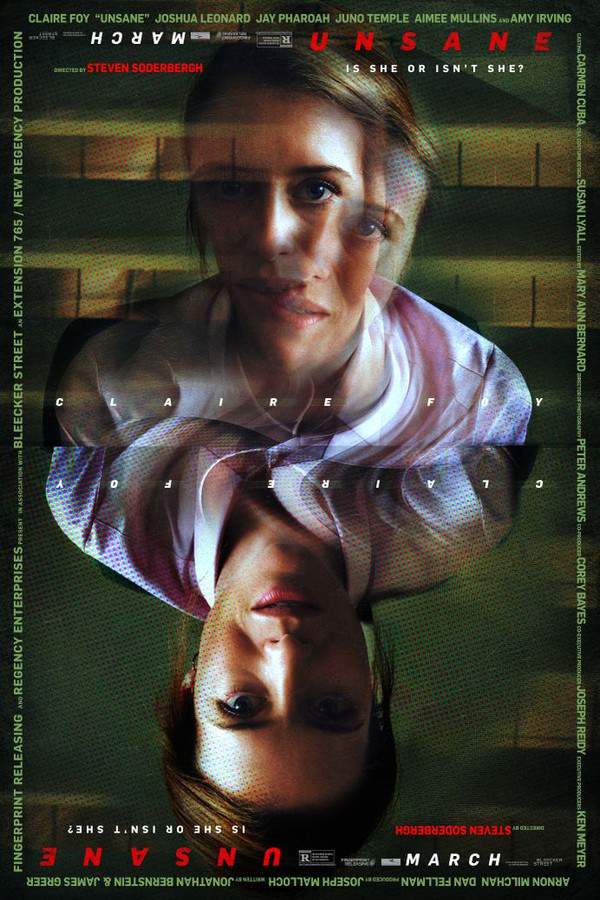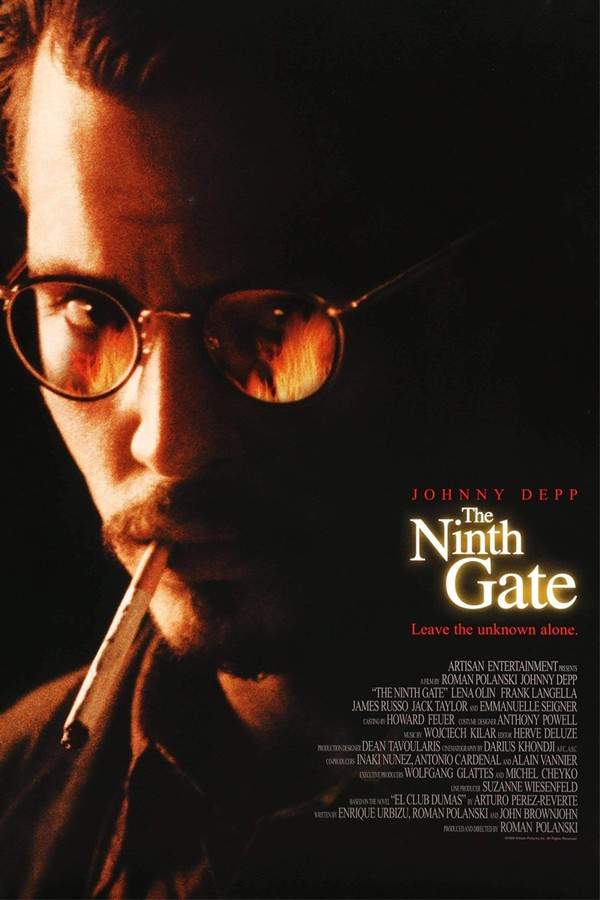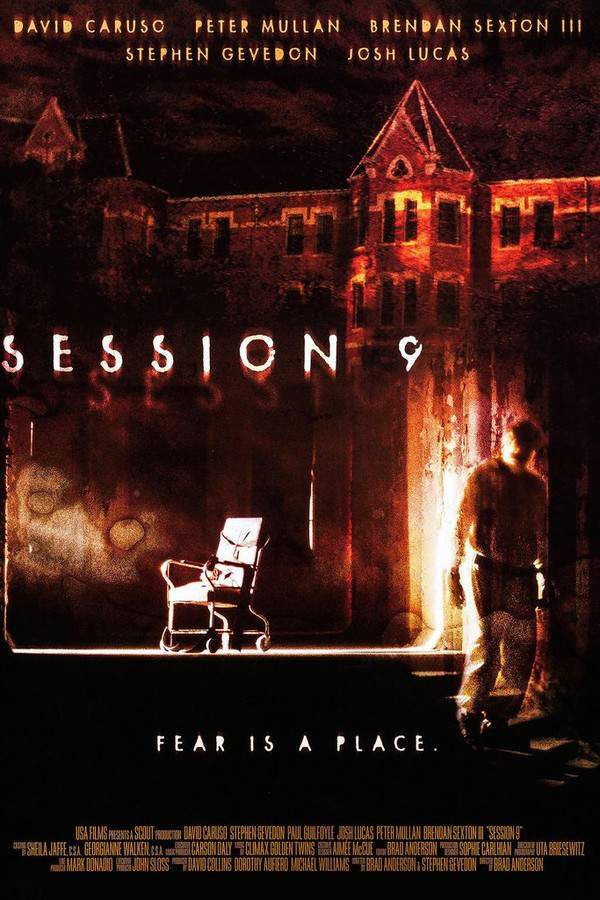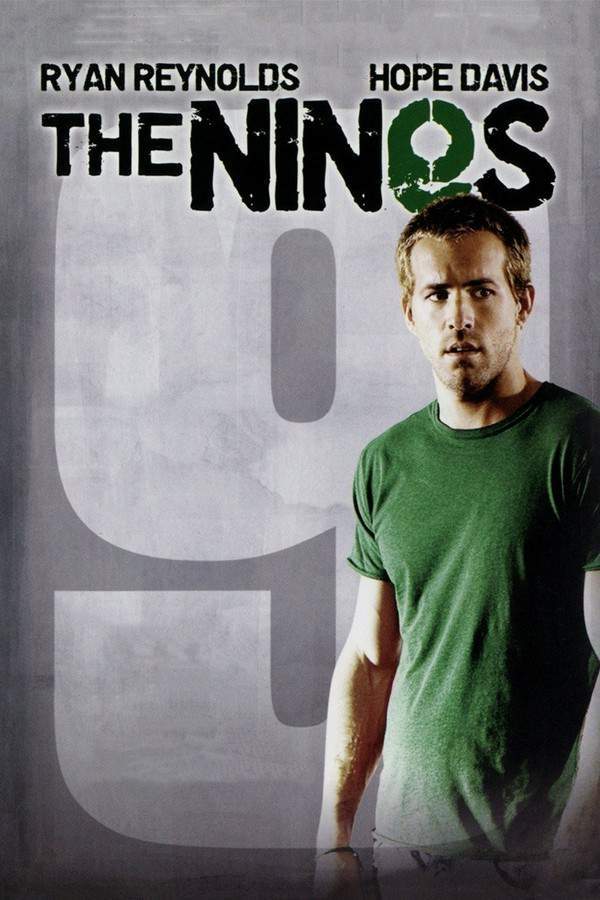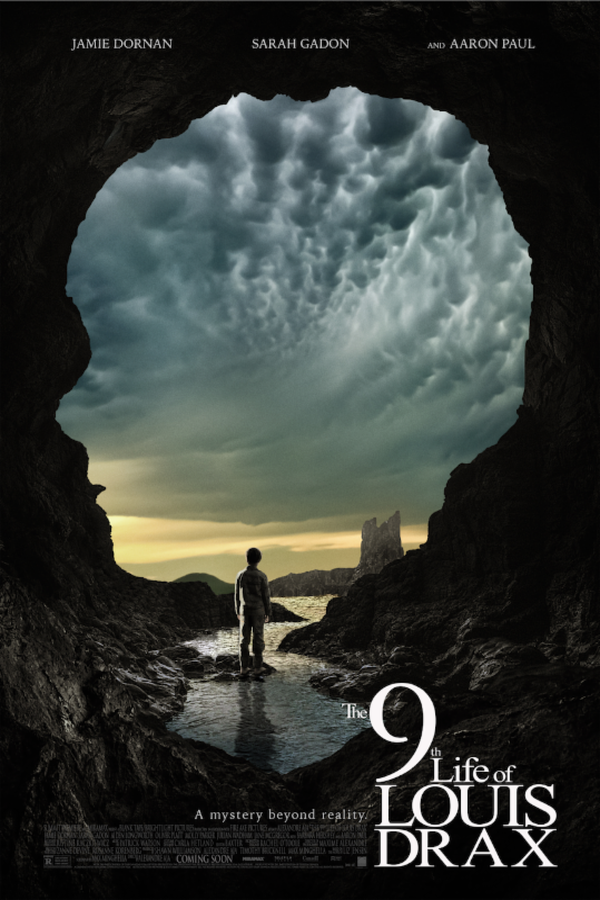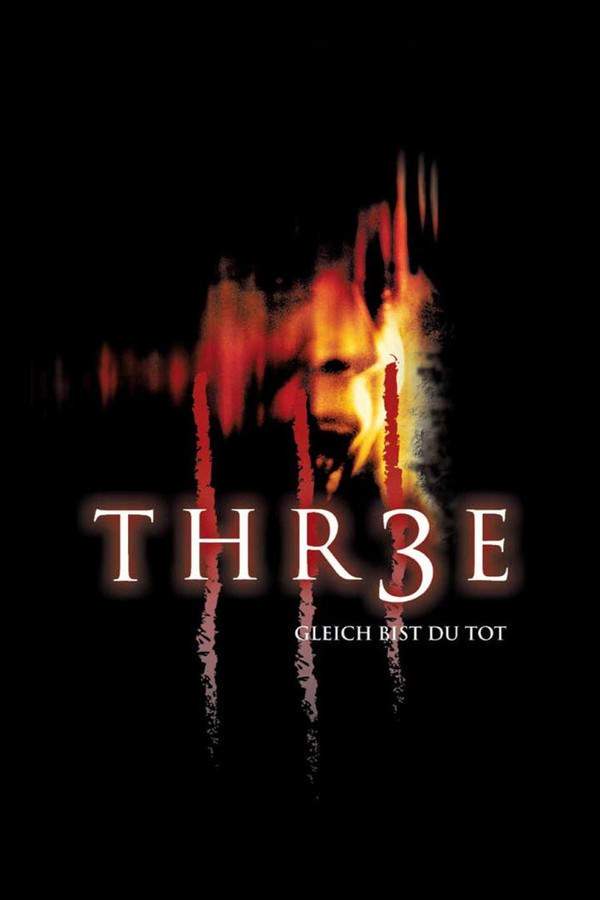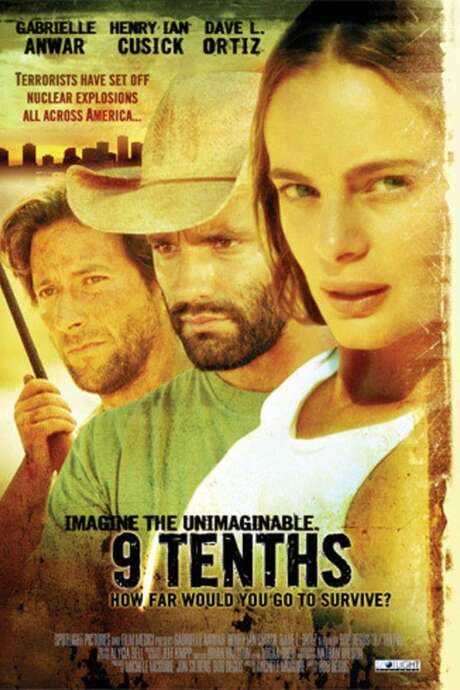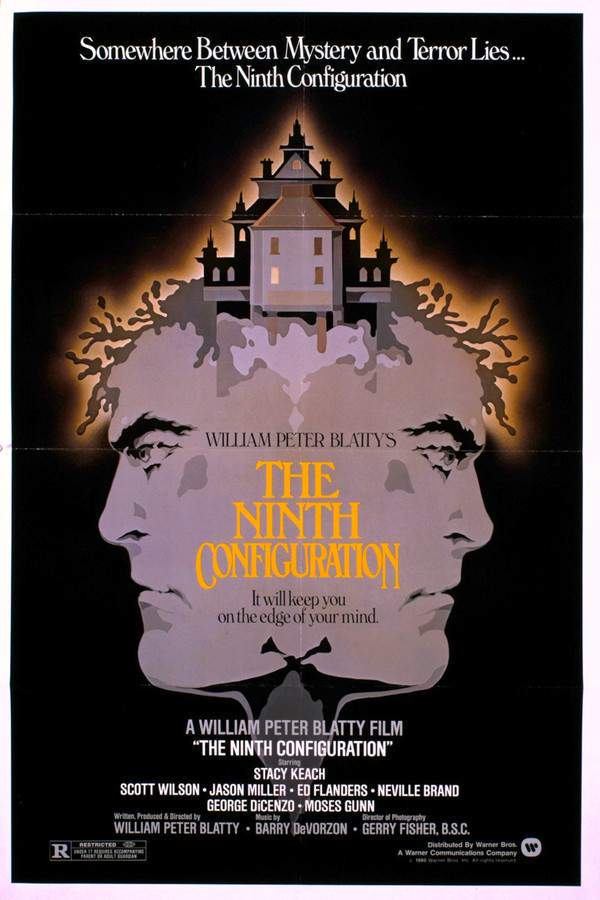
The Ninth Configuration 1980
Directed by

William Peter Blatty
Made by

Warner Bros.
Test your knowledge of The Ninth Configuration with our quiz!
The Ninth Configuration Plot Summary
Read the complete plot summary and ending explained for The Ninth Configuration (1980). From turning points to emotional moments, uncover what really happened and why it matters.
Billy Cutshaw, portrayed by Scott Wilson, is a former astronaut who has succumbed to madness and now resides in a grand castle nestled within the scenic forested regions of the Pacific Northwest. Meanwhile, Colonel Vincent Kane, played by Stacy Keach, a former United States Marine Corps officer plagued by recurrent nightmares, is en route to this enigmatic castle. On his journey, he encounters a pickup truck brimming with a raucous biker gang, and to his horror, he notices an elderly man bound to a chair in the back.
Upon his arrival at the castle, Kane quickly realizes that maintaining order among the unruly and irreverent patients is a daunting task for the castle’s military staff. He initially attempts to converse with a doctor, only to discover that the supposed physician is, in fact, another patient masquerading as one. It is then that Colonel Ed Flanders, who identifies himself as the genuine doctor, reveals the deception. Kane opens his office doors to several patients, encouraging them to share their personal delusions, warmly asserting his readiness to listen. In an unanticipated exchange, Cutshaw willingly offers Kane his saint’s medallion, prompting Kane to remark on the therapeutic effects of “shock therapy” as he inspects the medallion.
Later, Kane finds himself awakened from another tormenting nightmare by Fell, who inquires about the source of his distressing dreams. Kane shares that they belong to another man, someone he had heard describe them—the nightmare belongs to his brother, a man labeled as a “murderer.” This brother, notoriously known as Vincent “Killer” Kane, had a dark history, attributed to the deaths of countless enemies during his time as a guerrilla soldier. Kane reflects on the haunting truth that “Killer” Kane is now deceased, leaving Fell, who is actually Kane’s brother Hudson, to reminisce in sorrow as he departs.
As the story unfolds, Cutshaw engages in a thought-provoking conversation with another patient, questioning Kane’s sanity, and suggesting that those within the psychiatric profession often succumb to madness themselves. Cutshaw articulates a vehement denial of purpose or divine plan, prompting Kane to present his belief that God’s existence is more plausible than the randomness of human origin. The debate intensifies when Cutshaw demands an anecdote of selfless sacrifice from Kane’s own life, which Kane struggles to provide.
In a pivotal moment, Cutshaw persuades Kane to attend a church service with him. However, the service takes an unexpected turn when Cutshaw disrupts proceedings with his outbursts, while Kane grapples with a vivid hallucination of a Vietnamese boy. After the service, the gratitude expressed by Cutshaw turns into a request for a sign from Kane regarding the afterlife, an oath Kane earnestly promises to uphold.
Cutshaw meets another unique patient, Jason Miller, who is creatively directing a rendition of Hamlet featuring dogs as cast members. The interactive dialogue provides a moment of levity, as they discuss the blurred lines between sanity and madness, reflecting on the power of performance art. However, the atmosphere shifts as Kane confronts a moment from his past when a new soldier arrives, sending him spiraling into a traumatic flashback from Vietnam—a haunting episode that solidifies his trauma and guilt.
Kane’s internal battle continues as the staff, now aware of his true identity as Vincent “Killer” Kane, carefully orchestrates a façade, permitting him to play the role of the commanding officer in hopes of treating his mental state. After collapsing from his overwhelming memories, Kane’s unravelling forces him into a chilling confrontation.
In a desperate act, Cutshaw manages to escape the confining walls of the castle, only to be confronted and mercilessly assaulted by the very biker gang he previously encountered. In a moment of violent clarity, Kane arrives to rescue him, unleashing a terrifying fury that results in the demise of the bikers.
Back at the castle, Cutshaw finds Kane wrapped in a blanket and lost in his thoughts about God and the essence of human goodness. As Cutshaw departs, he witnesses a blood-stained knife slip from Kane’s grasp, leading him back to Kane’s office where he uncovers the harrowing truth: Kane has sacrificed himself to exemplify the very act of selflessness he could not articulate earlier.
Eventually, Cutshaw returns to uniform, revisiting the now-desolate castle. In an emotional moment, he discovers a heartfelt note from Kane, who hoped to provoke a return to sanity in Cutshaw’s heart through his ultimate sacrifice. As Cutshaw steps back to his car, he finds the saint’s medallion resting on the seat—a miraculous sign that rekindles hope and belief in a higher purpose.
The Ninth Configuration Timeline
Follow the complete movie timeline of The Ninth Configuration (1980) with every major event in chronological order. Great for understanding complex plots and story progression.
Billy Cutshaw's Madness
Billy Cutshaw, a former astronaut, succumbs to madness and takes refuge in a grand castle deep within the Pacific Northwest. His isolation reflects a tragic decline from his heroic past as he grapples with his internal demons.
Colonel Kane's Journey
Colonel Vincent Kane embarks on a journey to the castle while battling his traumatic nightmares. During his trip, he encounters a pickup truck full of rowdy bikers, where he witnesses an elderly man tied to a chair, heightening the tension of his journey.
Chaos at the Castle
Upon arriving at the castle, Kane discovers that controlling the unruly patients poses a significant challenge for the staff. His initial conversation with a supposed doctor ends up revealing that the man is himself a patient in disguise, emphasizing the absurdity of the situation.
The Real Doctor Revealed
Colonel Kane meets the real doctor, who identifies himself as Ed Flanders, another patient in the castle. This revelation deepens Kane's understanding of the blurred lines between sanity and insanity within the castle's walls.
Sharing Delusions
Kane opens his office to the patients, inviting them to share their delusions. Cutshaw, in a surprising act, gifts him a saint's medallion, which leads Kane to reflect on the power and necessity of ‘shock therapy’ for healing.
Nightmares Unveiled
Kane awakens from another nightmare, sharing with Fell (Kane's brother Hudson) the haunting tales of his deceased brother, known as Vincent 'Killer' Kane. This personal revelation adds depth to Kane's character and his emotional struggles.
Philosophical Debate
Cutshaw engages Kane in a philosophical discussion about sanity and the existence of a divine plan. Cutshaw's strong denial of purpose challenges Kane's beliefs, creating a tension-filled atmosphere of existential questioning.
The Church Service
Cutshaw convinces Kane to attend a church service, which quickly becomes chaotic as Cutshaw's disruptive behavior emerges. Amidst this turmoil, Kane experiences a haunting hallucination of a Vietnamese boy, intensifying his struggle with guilt.
A Unique Performance
Cutshaw meets another patient, Jason Miller, who is creatively directing a unique version of *Hamlet* featuring dogs. Their light-hearted discussion about art and madness provides a temporary lift amidst the oppressive environment of the castle.
Haunting Flashback
Kane experiences a traumatic flashback from his time in Vietnam when a new soldier arrives, leading him to confront a haunting memory. This moment encapsulates his unresolved guilt and the complexities of his military past.
The Facade of Command
The staff at the castle, aware of Kane's identity as Vincent 'Killer' Kane, allow him to assume the role of a commanding officer. This precarious arrangement is intended to assist in his mental treatment while exposing him to the reality of his trauma.
Cutshaw's Escape
In a desperate bid for freedom, Cutshaw escapes the confines of the castle. Unfortunately, he soon faces the violent biker gang from his earlier encounter, putting his life in jeopardy once again before Kane intervenes.
Terrifying Rescue
Kane arrives just in time to rescue Cutshaw from the attack of the bikers. In a fit of rage and desperation, Kane unleashes his fury, resulting in a visceral confrontation that showcases his internal battle and thirst for redemption.
The Bloody Revelation
Back at the castle, Cutshaw discovers Kane in deep contemplation about the nature of God and human existence. A blood-stained knife slips from Kane’s grasp, leading Cutshaw to uncover the harrowing truth about Kane’s ultimate sacrifice.
Final Farewell
In the aftermath of the revelations, Cutshaw finds a note from Kane expressing hope for his return to sanity. As he leaves the now-desolate castle, he discovers the saint's medallion, a final sign that reignites his belief in a higher purpose.
The Ninth Configuration Characters
Explore all characters from The Ninth Configuration (1980). Get detailed profiles with their roles, arcs, and key relationships explained.
Billy Cutshaw
Billy Cutshaw is a former astronaut who grapples with his descent into madness. His dialogue often reflects a disillusioned perspective on life and faith. His interactions with Kane push him to confront his beliefs and articulate his thoughts on purpose.
Colonel Vincent Kane
Colonel Vincent Kane bears the weight of his past traumas as a former Marine. His struggles with nightmares and guilt from his brother's actions encapsulate the theme of internal conflict. Kane's transformation throughout the film displays depth as he seeks understanding and healing.
The Ninth Configuration Settings
Learn where and when The Ninth Configuration (1980) takes place. Explore the film’s settings, era, and how they shape the narrative.
Time period
The film does not specify a particular time period but highlights themes prevalent in the mid-20th century, such as the psychological repercussions of war and a growing discourse around mental health. It subtly situates itself around the post-Vietnam War era, reflecting the trauma many veterans faced.
Location
Pacific Northwest, Castle
The movie is set in the serene and picturesque Pacific Northwest, characterized by its lush forests and sprawling landscapes. The central location is a grand castle, which serves as an asylum for the unrestrained patients. Known for its haunting beauty, the castle contrasts sharply with the turmoil faced by the characters inside.
The Ninth Configuration Themes
Discover the main themes in The Ninth Configuration (1980). Analyze the deeper meanings, emotional layers, and social commentary behind the film.
🧠
Madness
Madness serves as a central theme, questioning the fine line between sanity and insanity. The film explores how trauma, particularly from war, manifests in mental health struggles. Characters like Cutshaw and Kane reflect different facets of madness, prompting dialogues on purpose and divine existence.
✝️
Faith
Faith plays a pivotal role in the characters’ experiences and interactions. The narrative delves into existential questions about God and the afterlife, culminating in Cutshaw’s request for a sign from Kane. Their discussions highlight a search for meaning in the chaos of life.
🎭
Performance Art
The theme of performance art emerges as a reflective medium through which characters confront their realities. Through a humorous reinterpretation of *Hamlet,* the film demonstrates how creativity can serve as a coping mechanism for madness, blurring lines between sanity and performance.
❤️
Selflessness
Selflessness is ultimately portrayed as an act of redemptive sacrifice. Kane's climactic choice to save Cutshaw at the cost of his own safety signifies a profound moment of love and care. The film leaves audiences pondering the nature of human goodness and the legacy of sacrifice.

Coming soon on iOS and Android
The Plot Explained Mobile App
From blockbusters to hidden gems — dive into movie stories anytime, anywhere. Save your favorites, discover plots faster, and never miss a twist again.
Sign up to be the first to know when we launch. Your email stays private — always.
The Ninth Configuration Spoiler-Free Summary
Discover the spoiler-free summary of The Ninth Configuration (1980). Get a concise overview without any spoilers.
In a remote stretch of the Pacific Northwest, a sprawling, medieval‑style castle has been converted into a military asylum where the line between sanity and delusion blurs beneath stone arches and mist‑shrouded woods. The institution houses a collection of eccentric patients whose peculiar behaviors hint at deeper wounds, creating an atmosphere that feels both cloistered and otherworldly. The film’s tone is a slow‑burning blend of psychological drama and existential mystery, where quiet corridors echo with whispers of faith, trauma, and the search for meaning.
Vincent Kane, a colonel turned military psychiatrist, arrives at the castle burdened by recurring nightmares and a stoic sense of duty. His background as a Marine officer and his recent appointment to assess the patients set up a compelling tension between his disciplined exterior and the chaotic inner lives he must confront. Kane’s methodical approach is challenged by the strange rituals and cryptic conversations that permeate the ward, forcing him to question the limits of his training and the very nature of reality.
Among the residents is Billy Cutshaw, a former astronaut whose brilliant career has given way to a haunting psychological decline. Cutshaw’s presence introduces a stark contrast: a man once devoted to exploring the cosmos now grapples with inner darkness that feels as expansive as the void he left behind. Their interactions become a study in contrasts—discipline versus disarray, scientific rationalism against lingering spiritual doubt—each probing the other’s deepest convictions.
As Kane delves deeper into the castle’s unsettling world, the film maintains a steady, unsettling rhythm, allowing the audience to linger on the uneasy camaraderie and the lingering questions about belief, purpose, and the fragility of the human mind. The story promises a meditation on whether true healing lies in confronting one’s own ghosts or embracing the mysteries that defy explanation.
Can’t find your movie? Request a summary here.
Movies with Similar Twists and Themes
Uncover films that echo the narrative beats, emotional arcs, or dramatic twists of the one you're exploring. These recommendations are handpicked based on story depth, thematic resonance, and spoiler-worthy moments — perfect for fans who crave more of the same intrigue.
Featured on this page

What's After the Movie?
Not sure whether to stay after the credits? Find out!
Explore Our Movie Platform
New Movie Releases (2025)
Famous Movie Actors
Top Film Production Studios
Movie Plot Summaries & Endings
Major Movie Awards & Winners
Best Concert Films & Music Documentaries
Movie Collections and Curated Lists
© 2025 What's After the Movie. All rights reserved.


